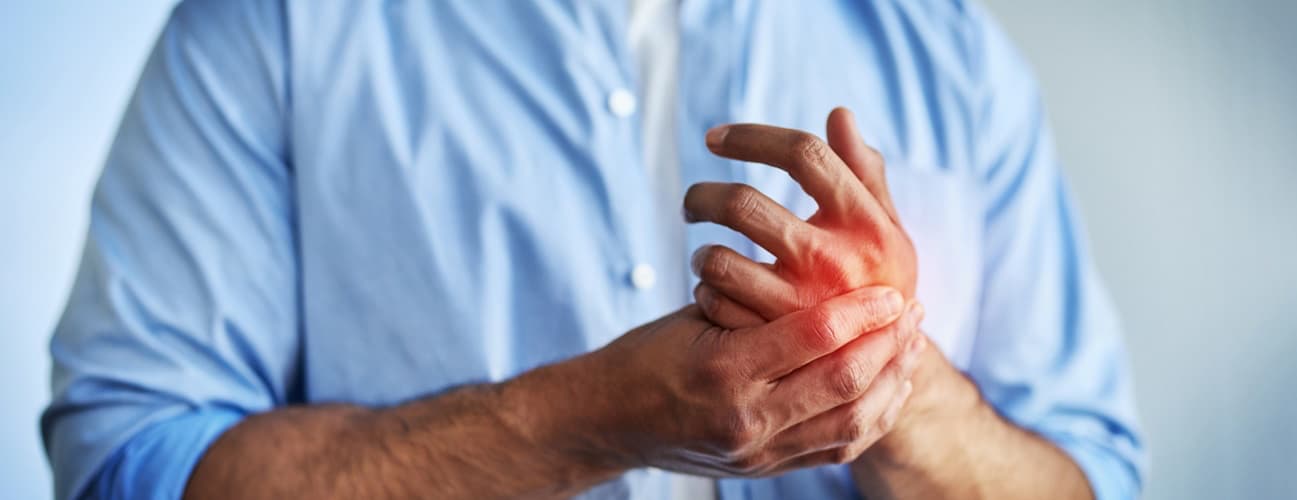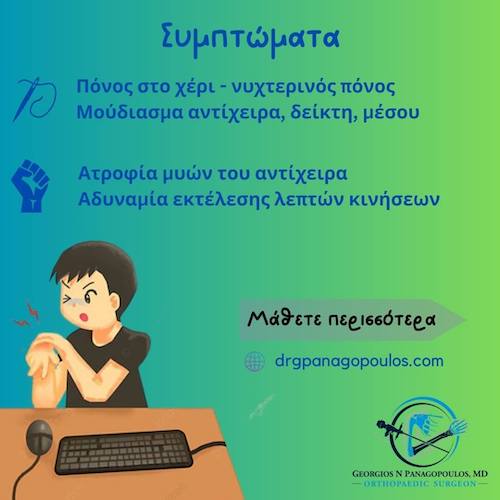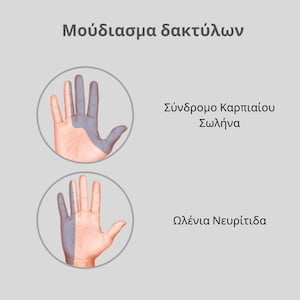Georgios Panagopoulos MD | Orthopaedic Surgeon

Table of contents
What is carpal tunnel syndrome?
Carpal tunnel syndrome is caused by increased pressure of the median nerve at the wrist. It is a very common condition that causes numbness, tingling and pain at the hand and wrist. The median nerve provides sensation to the thumb, index, and middle fingers, and to half of the ring finger. The small finger (the “pinky”) is typically not affected.



Who is at risk for carpal tunnel syndrome?
The median nerve, along with the other 2 peripheral nerves of the arm (the radial and the ulnar nerve) is responsible for sensation and motion of the fingers of the hand. Along its path, the median nerve passes through a narrow tunnel at the level of the wrist, called the carpal tunnel, defined by the carpal bones and the thick transverse ligament. This is where excessive pressure to the nerve can precipitate carpal tunnel syndrome.
Predisposing factors that may lead to carpal tunnel syndrome include:
- Hereditary factors (carpal tunnel can run in the family)
- Age
- Sex (women more susceptible)
- Pregnancy
- Wrist fractures
- Arthritis (rheumatoid, gout)
- Diabetes mellitus
- Thyroid disorders
- Alcohol
Workers at risk for carpal tunnel syndrome are those who do jobs that involve repetitive finger Repetitive activities in the workplace that include forceful or repetitive gripping or vibration can increase symptoms.
What are the symptoms of carpal tunnel syndrome?
The symptoms of carpal tunnel syndrome may include:
- Pain in the wrist, palm and fingers, often worse at night νυχτερινές ώρες (ο ασθενής ξυπνάει και νιώθει ανακούφιση με το τίναγμα των δακτύλων)
- Numbness & tingling, often worse at night, especially in the thumb, index & middle fingers
- Waking up at night, having to shake hand or hold over the side of the bed
- Fingers feeling fuzzy or swollen
- Dropping objects - clumsiness, weak pinch & grip
- Atrophy of the hand muscles, in severe cases
Symptoms usually start gradually, with frequent numbness or tingling in the fingers, especially the thumb, index and middle fingers. Some patients say their fingers feel useless and swollen. The symptoms often appear first during the night. The dominant hand is usually affected first and produces the most severe symptoms. Some people may wake up feeling the need to “shake out” the hand or wrist. Certain activities such as talking on the phone, reading a book or newspaper, or driving may exacerbate symptoms. Symptoms are initially intermittent but can become permanent, as severity of the condition increases. Hand weakness may make it difficult to perform fine manual tasks or grasp small objects. In chronic or untreated cases, the muscles at the base of the thumb may waste away (thenar atrophy).
Diagnosis
Η διάγνωση του συνδρόμου καρπιαίου σωλήνα βασίζεται κατά κύριο λόγο στο ιστορικό του ασθενούς και στην κλινική εξέταση. Κατά την επίσκεψή σας, ο κ. Παναγόπουλος θα λάβει λεπτομερές ιστορικό, θα σας εξετάσει και θα σας υποβάλλει σε υπέρηχο, για τον καθορισμό της διαμέτρου του μέσου νεύρου στον καρπό. Ο ιατρός, επίσης, θα σας παραπέμψει για ηλεκτροφυσιολογικό έλεγχο ή ηλεκτρομυογράφημα , για την επιβεβαίωση της διάγνωσης και τον καθορισμό της βαρύτητας της νόσου.

Non-surgical treatment
Non-surgical treatment options for carpal tunnel syndrome may include:
- Rest
- Stretching exercises.
- Χρήση νυχτερινού νάρθηκα καρπού για σύνδρομο καρπιαίου σωλήνα
- Τροποποίηση δραστηριοτήτων (αποφυγή χρήσης καρπού σε συνεχή κάμψη, ρύθμιση ύψους καρέκλας γραφείου, αλλαγή πληκτρολογίου, συχνά μικρά διαλείμματα)
- Physiotherapy/home exercise program
- Steroid injection in the carpal tunnel, under ultrasound guidance. This can also be diagnostic, in cases with atypical symptoms, or if diagnosis is unclear.
Σύνδρομο Καρπιαίου Σωλήνα & Ασκήσεις
Η φυσικοθεραπεία και ένα πρόγραμμα ασκήσεων στο σπίτι μπορούν να οδηγήσουν σε παροδική ανακούφιση των συμπτωμάτων. Οι ασκήσεις περιλαμβάνουν διατάσεις του καρπού και των δακτύλων και έχουν ως σκοπό την καλύτερη ολίσθηση του μέσου νεύρου στον καρπιαίου σωλήνα.
Surgical treatment
Η χειρουργική θεραπεία ενδείκνυται σε περίπτωση αποτυχίας της συντηρητικής θεραπείας ή σε περίπτωση νόσου προχωρημένης βαρύτητας. Το κόστος του χειρουργείου είναι αρκετά προσιτό. Η χειρουργική επέμβαση διαρκεί 10 λεπτά και πραγματοποιείται με τον ασθενή ξύπνιο, υπό τοπική αναισθησία. Ο χειρουργός πραγματοποιεί μία μικρή τομή στη βάση του παλάμης και απελευθερώνει τον εγκάρσιο σύνδεσμο, ανακουφίζοντας την πίεση στο μέσο νεύρο. Ο ασθενής επιστρέφει στο σπίτι λίγες ώρες μετά την επέμβαση με μια περίδεση στο χέρι για λίγες μέρες. Τα αποτελέσματα της επέμβασης αποσυμπίεσης του μέσου νεύρου στον καρπό είναι πολύ καλά, με εξαιρετικά χαμηλό ποσοστό επιπλοκών. Πολλοί ασθενείς αναφέρουν σημαντική βελτίωση των συμπτωμάτων, ειδικά του νυχτερινού πόνου, λίγες μέρες μετά το χειρουργείο.
Please contact us for more information.
FAQs - Frequently Asked Questions
What is carpal tunnel syndrome?
It is an entrapment syndrome of the median nerve at the wrist.
What are the predisposing factors?
– Hereditary factors
– Age
– Sex (women are more susceptible)
– Pregnancy
– Wrist fractures
– Arthritis (rheumatoid, gout, etc)
–Diabetes mellitus
– Thyroid disorders
– Alcohol
What are the symptoms?
– Numbness & tingling in the thumb, index and middle fingers
– Pain in the wrist, palm and fingers, often worse at night
– Clumsiness, dropping objects, inability to perform fine motor hand movements
– Atrophy of the hand muscles, in severe cases
What is the surgical treatment?
Carpal tunnel release under local anaesthetic
Ποιο είναι το τεστ για σύνδρομο καρπιαίου σωλήνα?
Η διάγνωση μπορεί να γίνει από το ιστορικό, την κλινική εξέταση & το ηλεκτρομυογράφημα.
Find us
Book an appointment with us today
